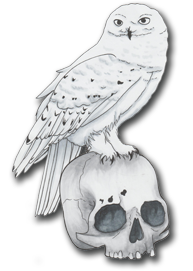Notes on Common Practices
During the course of the research that I'm conducting, I've come across several different processes that appear to be consistent when working with leather in general. The following information is intended to be a reference point for myself and others in conjunction with the other information that I'm posting during my research.
"then scrape out that water with the back of a knife"1
The first time that I read this, it sounded odd to reference a knife in the wringing of the skin. I mean really, really odd. Odd enough that I had to take some time and really think about what the point was in this process. It also prompted me to do some experimentation in general with the scraping of the back of a knife on a piece of leather.
So, I wet down a piece of scrap, let it dry, then repeated the process a couple more times. What I ended up with was a relatively stiff piece of scrap leather that was heavily water stained. This was done intentionally, since wetting leather repeatedly (with or without dye) tends to make it stiffer. Granted, I'd seen this many times over in the past while just working with leather, but I never thought anything about it.
Now enter the rigid surface into the equation.
I started scraping at the scrap with the back of a metal ruler, since it was blunt. After looking over the piece, there was not much difference. It occurred to me though that I was working with a piece of scrap, where the references that I saw that made note of using the back of a knife were talking about the full skin. So it occurred to me that either the skin or the knife would have to be fixed into something that was more like a rigid surface. Since scraping at the scrap was not really getting me anywhere, I decided to try and roll the skin over the corner of my work table. The outcome made absolute sense.
When passing the scrap over the corner, what I found was that the leather started to loosen up some, regaining some lost flexibility.
The corner of the table is relatively broad, but I'm assuming that a fixed blade on a saw horse type structure would give a relatively
small surface
to be able to get the side rounded over. With my wood working, I use a "shoe shine" method to curve out the squared
edges of a piece in a similar manner.
So, if the leather is repeatedly worked over a fixed narrow point, it should regain flexibility by breaking up the fibers
of the leather. Subsequently, by using this method of breaking up the fibers, the side should also allow for more dye to
soak in using a final dunking in the color that you are using.
Constructive feedback is both welcome and appreciated, please let me know if I missed some pertinent information or if there's somewhere I can improve.
As always, thanks for reading!
Ihone
- The secrets of the reverend Maister Alexis of Piemont by Girolamo Ruscelli.
OL 25228326M - Translated from French into English by William Ward
There is a viewable pdf on Open Library
